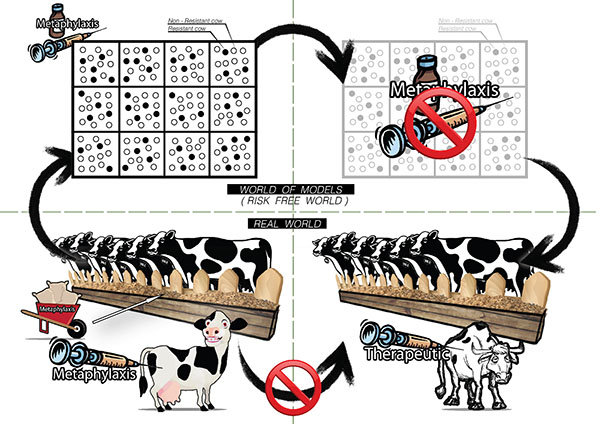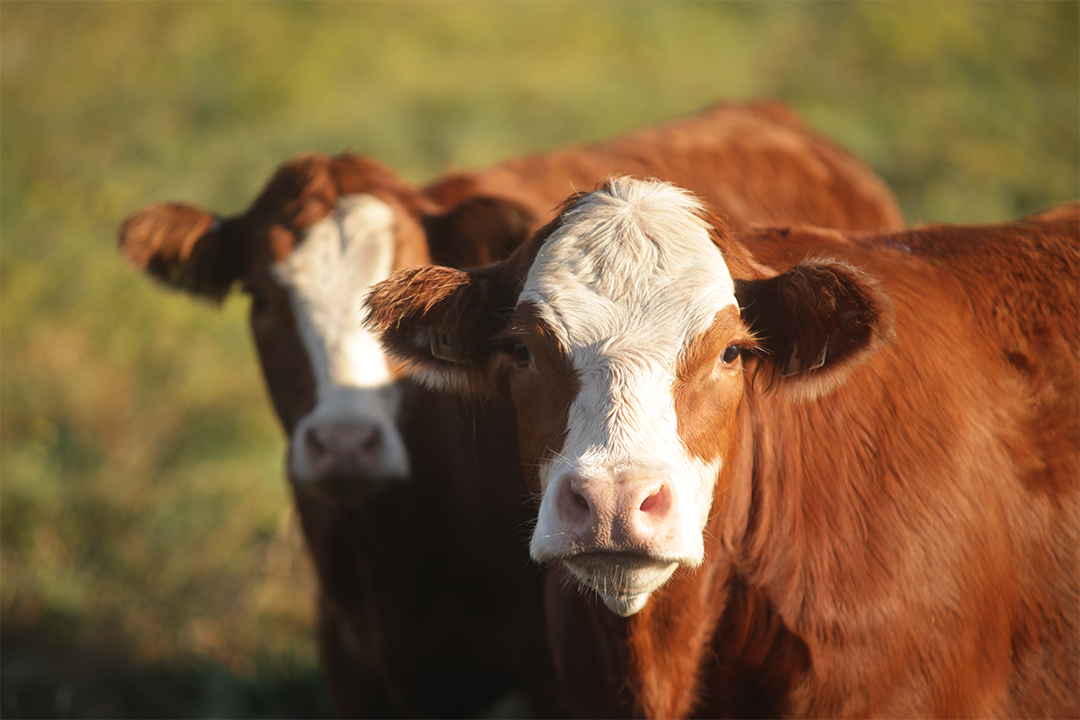Six years later with an animal science degree now in hand, I'm realizing this reality through my graduate program in the Western College of Veterinary Medicine's (WCVM) Department of Large Animal Clinical Sciences.
I'm investigating the transmission of antimicrobial resistance (AMR) between animals, people and the environment through the use of computational modelling to gain a better understanding of an emerging issue in agriculture.
The World Health Organization has singled out AMR as one of the major health issues threatening the public. AMR occurs when microorganisms develop the ability to continue multiplying in the presence of antibacterial, antiviral, antiparasitic or antifungal substances to which they were formerly sensitive.
The evolution of resistant strains is a natural phenomenon that occurs following errors in the replication process. The resulting gene mutations can then be shared with other bacteria. However, the misuse and overuse of antimicrobial drugs has accelerated the emergence of drug-resistant strains around the globe.
Although scientists are still debating about the significance of antimicrobial use in agriculture and its contributions to AMR, research has linked the use of antibiotics in livestock production to the emergence of antimicrobial-resistant, foodborne pathogens.
To examine how emerging threats from AMR might affect the sustainability of livestock production and human health, WCVM professor Dr. Cheryl Waldner and her research team are working to develop computational models to describe this issue in Western Canada. The models are computer programs that attempt to map and simulate the real-world scenario. This model will help the agriculture industry better understand the spread of resistant organisms through the entire livestock value chain.

Waldner has long understood the potential of computer science in solving complex, real-world problems.
"Herd medicine and epidemiology require data management skills. However, relatively few veterinarians have the programming background necessary to fully exploit many of the tools needed to address complex problems such as the relationship between antimicrobial use and AMR," says Waldner, who supervises my graduate research work.
From her perspective, my diverse background in computer science and animal science offers a unique opportunity to merge the two fields and learn more about AMR in livestock production.
Computational modelling has many benefits and applications to agricultural research. In this case, modelling provides an alternative or a supplement to expensive and complex live animal studies. It's also a low-risk platform that allows researchers to test a wide range of scenarios without the potential for concerns regarding impacts on animal health or the environment.
In previous AMR research, scientists have identified the presence of resistant organisms throughout the production system — from feedlots and swine barns to processing facilities to the consumer's plate. Waldner and her team hope to integrate this information using modelling to evaluate policies that will limit AMR development and spread.
Using a complex systems approach, I will create a simulation model to examine AMR transmission pathways. My outcomes will include the frequency of AMR organisms at successive stages of the system structure, and this information will allow me to identify resistance patterns, control points and potential preventive solutions.
Ultimately, we believe the model will help to bring more awareness of antimicrobial use and resistance issues to the livestock industry. We also anticipate that effective controls may aid in reducing the prevalence of AMR in agriculture while simultaneously serving as a reference for future government policies and guidelines related to antimicrobial use.
Our team is initially working with the beef cattle industry, starting with feedlot production before expanding to cow-calf operations. We hope to integrate similar models from the swine and poultry industries to eventually create a comprehensive overview of the major livestock sectors that contribute to animal-based food production in Canada.
Eventually, the project will also explore the potential role that the environment may play in the spread of resistant bacteria through livestock production (for example, the spread of manure on field or runoff on pasture). In the end, Waldner hopes this research will help improve our understanding of how to minimize the potential effects of antimicrobial use in agriculture on resistant bacteria in animal and human populations.
Michelle Pang of Edmonton, Alberta, is a combined Master of Science student in epidemiology and DVM student at the WCVM. Michelle's story is part of a series of stories written by WCVM students who are part of the veterinary college's research program.
I'm investigating the transmission of antimicrobial resistance (AMR) between animals, people and the environment through the use of computational modelling to gain a better understanding of an emerging issue in agriculture.
The World Health Organization has singled out AMR as one of the major health issues threatening the public. AMR occurs when microorganisms develop the ability to continue multiplying in the presence of antibacterial, antiviral, antiparasitic or antifungal substances to which they were formerly sensitive.
The evolution of resistant strains is a natural phenomenon that occurs following errors in the replication process. The resulting gene mutations can then be shared with other bacteria. However, the misuse and overuse of antimicrobial drugs has accelerated the emergence of drug-resistant strains around the globe.
Although scientists are still debating about the significance of antimicrobial use in agriculture and its contributions to AMR, research has linked the use of antibiotics in livestock production to the emergence of antimicrobial-resistant, foodborne pathogens.
To examine how emerging threats from AMR might affect the sustainability of livestock production and human health, WCVM professor Dr. Cheryl Waldner and her research team are working to develop computational models to describe this issue in Western Canada. The models are computer programs that attempt to map and simulate the real-world scenario. This model will help the agriculture industry better understand the spread of resistant organisms through the entire livestock value chain.

Waldner has long understood the potential of computer science in solving complex, real-world problems.
"Herd medicine and epidemiology require data management skills. However, relatively few veterinarians have the programming background necessary to fully exploit many of the tools needed to address complex problems such as the relationship between antimicrobial use and AMR," says Waldner, who supervises my graduate research work.
From her perspective, my diverse background in computer science and animal science offers a unique opportunity to merge the two fields and learn more about AMR in livestock production.
Computational modelling has many benefits and applications to agricultural research. In this case, modelling provides an alternative or a supplement to expensive and complex live animal studies. It's also a low-risk platform that allows researchers to test a wide range of scenarios without the potential for concerns regarding impacts on animal health or the environment.
In previous AMR research, scientists have identified the presence of resistant organisms throughout the production system — from feedlots and swine barns to processing facilities to the consumer's plate. Waldner and her team hope to integrate this information using modelling to evaluate policies that will limit AMR development and spread.
Using a complex systems approach, I will create a simulation model to examine AMR transmission pathways. My outcomes will include the frequency of AMR organisms at successive stages of the system structure, and this information will allow me to identify resistance patterns, control points and potential preventive solutions.
Ultimately, we believe the model will help to bring more awareness of antimicrobial use and resistance issues to the livestock industry. We also anticipate that effective controls may aid in reducing the prevalence of AMR in agriculture while simultaneously serving as a reference for future government policies and guidelines related to antimicrobial use.
Our team is initially working with the beef cattle industry, starting with feedlot production before expanding to cow-calf operations. We hope to integrate similar models from the swine and poultry industries to eventually create a comprehensive overview of the major livestock sectors that contribute to animal-based food production in Canada.
Eventually, the project will also explore the potential role that the environment may play in the spread of resistant bacteria through livestock production (for example, the spread of manure on field or runoff on pasture). In the end, Waldner hopes this research will help improve our understanding of how to minimize the potential effects of antimicrobial use in agriculture on resistant bacteria in animal and human populations.
Michelle Pang of Edmonton, Alberta, is a combined Master of Science student in epidemiology and DVM student at the WCVM. Michelle's story is part of a series of stories written by WCVM students who are part of the veterinary college's research program.
Share this story
